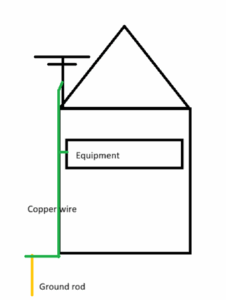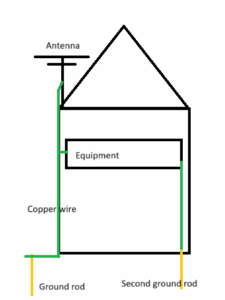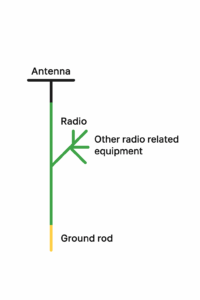Introduction
Welcome to our guide, created with the goal of supporting the amateur radio community.
We’re passionate about helping radio enthusiasts of all levels by sharing knowledge, resources, and practical advice.
Alongside this guide, we design and supply high-quality products and filters tailored to the specific needs of our customers.
Every item we produce is crafted with care and precision, ensuring the best possible performance for your radio experience.
Our mission is simple: to help the community grow while providing tools and products that meet the highest standards.
If you have any questions or comments use our contact form and we will respond as soon as possible.
Radio frequency interference
Radio frequency interference (RFI) is a challenge every amateur radio operator has encountered at some point, whether during a casual QSO or in the middle of a contest. With today’s world being saturated by wireless devices, switching power supplies, LED lighting, and broadband internet equipment, the RF environment is far noisier than it was just a few decades ago. For amateur radio operators, that extra noise can mean missing a weak DX station, struggling through distorted signals, or finding entire bands unusable.
Understanding the type of sources and the possible solutions to RFI is more important than ever for the ham radio community. While RFI is not a new problem—operators have been chasing down “phantom signals” since the earliest days of radio. Modern electronics and densely packed neighborhoods have introduced new forms of interference that require both technical knowledge and persistence to solve. For amateur radio operators, addressing RFI isn’t just about cleaner signals; it’s about preserving the enjoyment of experimentation, and community spirit that make amateur radio so unique.
Sources of RFI
RFI comes from a wide range of natural and man-made sources and knowing where it originates is the first step toward resolving it.
Natural sources include atmospheric noise from thunderstorms, static discharges, and solar activity. While these cannot be eliminated, operators can learn to recognize their unique signatures. For example, lightning typically produces broadband “crashes” across HF bands, while solar flares may cause sudden increases in noise levels or even temporary blackouts of certain bands.
Man-made sources are far more common in today’s RF environment. Switching power supplies—found in almost everything from computers to phone chargers and LED lighting—are notorious for radiating broadband noise across the spectrum. Broadband internet equipment, such as DSL modems and cable TV systems, can leak RF into nearby lines. Power line noise, often caused by loose or corroded connections on utility poles, is another widespread culprit that can wipe out entire bands.
Finally, self-induced interference—from your own equipment—shouldn’t be overlooked. Sometimes the noise is coming from the operator’s own computer, switching power supply, or even improperly grounded equipment. Identifying whether interference is external or internal can save hours of frustrating troubleshooting.
Methods to suppress RFI
After 20+ years of experience with designing filters, installing radio equipment and investigating RFI at various locations we at EuroRF Design will share with you the best methods for mitigation.
Grounding
It all starts with grounding. This is specifically important if you use HF (high-frequency) radio equipment or are in an area with a high chance of lightning.
Many antennas require proper grounding, this is basically the counterpoise of the antenna, and without grounding the antenna will not function correctly. Secondly if there is no grounding there I no other way for spurious energy (like lightning) in the air to go other than down the center of the coax cable and into your equipment, possibly damaging your equipment in the process.
Grounding is usually done by driving a metal (specifically copper) rod into the ground to a certain depth, so the rod makes permanent contact with moisture in the ground. This way you are coupling the rod to the earth so there is basically little to no electrical resistance between earth and the rod.
From there a quite thick metal (preferably copper) wire is connected to the mast on where the antenna is mounted. This ensures that the antenna has a counterpoise and spurious energy from the air can reach the ground without going into the radio equipment.
Secondly also the radio equipment needs to be grounded, this should be grounded to the same ground rod. Do not connect radio equipment to ground that comes out of the house/office electrical socket, this way you will get RFI into the equipment since that ground can be “dirty”.
Some countries local power regulations do require you to bond all the ground rods together, but there is a risk of RFI.
Caution: Always follow your local laws and regulations.
Caution: Never ground antennas or radio equipment direction to the ground from an electrical outlet.
This is the ideal situation:
This is not the preferred situation:
The reason for this is there is no guarantee that the electrical resistance is 0 ohms between the 2 ground rods, also you now have a “ground loop” meaning there could be current flow between the 2 rods via ground or via the chassis in the radio equipment. And equipment that may send RFI into the second ground rod on the house’s electrical system is now ending up in your antenna ground.
Make sure the radio equipment is connected to the ground in a “star” like pattern, and that is all connections come together at one point, which then runs down to the ground rod.
Example:
Note: We strongly advise using lightning arrestors on your antenna feed lines. A lightning arrestor provides a safe discharge path for high-voltage spikes caused by lightning strikes or nearby electrical activity, protecting both your radio equipment and your property. Properly installed, it helps prevent costly damage and reduces the risk of fire.
You can find high-quality lightning arrestors in our webshop.
Suppressing RFI using ferrite
Suppressing RFI using ferrite is common, you can usually find ferrite beads at the end of DC charging cables and sometimes on Coax cables. Ferrite is a ceramic-like material mainly made from iron oxide. This specific material is magnetically conductive but has high electrical resistance.
In short: Ferrite beads work by resisting and dissipating high-frequency RF currents as heat, while allowing low-frequency signals and DC to pass through normally.
There are specific ferrite “mixes” to suppress different frequencies, the best mix to suppress HF RFI is Mix 31 (1-30 MHz), Mix 43 (25-250 MHz) and Mix 77 for RFI below 5 MHz. Mix 31 is the most broadly used for HF + low VHF suppression.
Ferrite comes in many “pressed” forms like toroids, clip-on beads, cylinders, wirewound, smd, sleeves, cores etc. Clip-on beads are usually found on Coax and power cables, and toroids for example in RF filters.
Suppressing RFI from ground
The easiest way to suppress HF RFI on ground is by using clip-on ferrite beads, you can find these in our webshop in various sizes and mixes. (for different cable diameters and frequencies). Place 3-6 of the beads as close to each other on the ground wire as possible and as close to the ground rod as possible. Put vulcanizing tape over the beads and put electrical tape over that so no water can leak between the ground wire and the beads, basically waterproofing the wire and the beads.
Suppressing RFI on DC cables
We are assuming the radio equipment runs on DC from an AC to DC power supply. The ground from the AC side is often coupled to the negative pole on the DC side. Meaning RFI from the AC ground goes though the chassis into the DC negative pole of the radio equipment. To suppress RFI in this situation we suggest mixing beads of type 31 and 43 (1-2 of each), both on the positive and negative DC leads, and loop the leads 4-5 times through the ferrite beads. By looping the cables through multiple times you are increasing the resistance and making the suppression more effective.
We also advise using non-switching power supplies for radio equipment, like linear regulated power supplies. These are more expensive and much heavier, but it generates less RFI by itself.
Suppressing RFI on Coax cables
Coax cables can pick up RFI from nearby equipment, like air conditioners, motors, power supplies, Wi-Fi equipment etc. This can go into the radio equipment and leak into the radio signal and possibly damage the radio.
This is often referred to as common-mode noise, it appears equally on multiple conductors with respect to ground.
The most effective way to block RFI on Coax cables is by using a common-mode filter, this kind of filter blocks noise that is identical on multiple conductors (common mode) while allowing the intended differential signal to pass through.
You can find common-mode filters in our webshop.
The best placement for such a filter is just below the antenna, approx. 1m from the feed point and one at the radio. The filter does not need to be grounded.
If a common-mode filter is not available we advise using ferrite clip-on beads to suppress RFI (select right mix and diameter), place 6-8 beads as close to each other as possible on the outside of the coax approx. 50cm from the feed point of the antenna, waterproof it. And do the same on the radio side. This is not as effective as a common mode filter, but it comes close.
Suppressing RFI on USB cables
Our advised method to suppress RFI from USB cables is by using a galvanic isolator. A galvanic isolator lets data and power pass between a computer and a device while breaking the direct electrical connection to prevent noise, ground loops, and shocks.
You can find isolators in our webshop.
If a galvanic isolator is not available you can also use ferrite clip-on beads on the USB cable, select the right mix and diameter. Loop the USB cable 4-5 times through the bead at both ends. It should not interfere with data transfer on USB 1.1 and 2.0. On USB 3.0 and higher we strongly advise a galvanic isolator, but these are rare and usually very expensive,